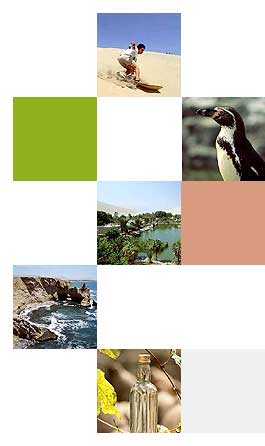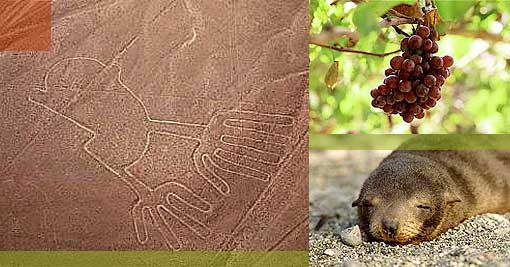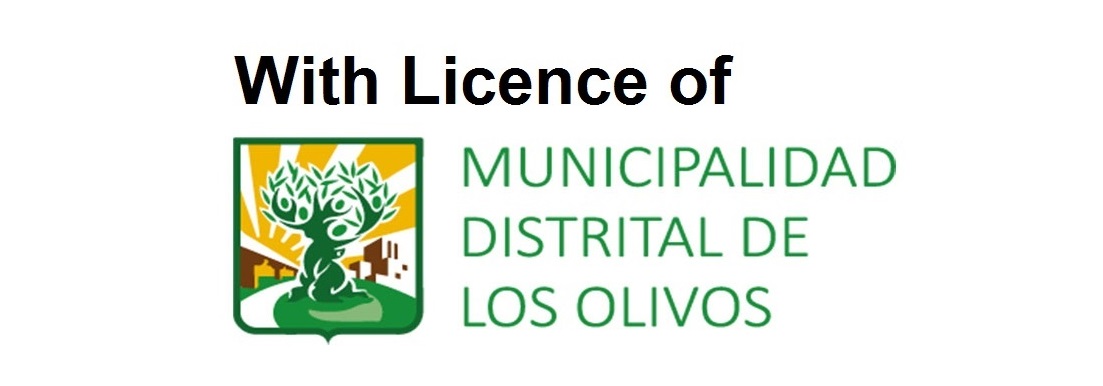

MAIN DESTINIES
Paracas / Ica / Nazca
 On the fields of Palpa, Ingenio, Nazca and Socos, there are the "Nazca's lines", a complex of 32 geoglifos of marine and terrestrial animals, human and geometrical figures that cover the area of 350 km2.
The city of Ica is famous by its field and the good quality of the wines and rums.
On the fields of Palpa, Ingenio, Nazca and Socos, there are the "Nazca's lines", a complex of 32 geoglifos of marine and terrestrial animals, human and geometrical figures that cover the area of 350 km2.
The city of Ica is famous by its field and the good quality of the wines and rums.
The legend of Huacachina
There is a legend that tells about a lady, that after knowing that her fiancé was died in the war, she refuge in the edge of the lagoon under a tree of huarango, looking for consolation to the tears that were born from her soul.
But she was seen by a chaser that tried to reach her. She run away to the water and disappeared in the deepness, to become a siren. Some people say that during full moon, when everything is quiet, she come out from the lagoon, and you can hear her painful singing. And people form Ica say that from time to time the lady attracts some swimmer and stays with him to make her company.
In Ica is also an obligation to taste the typical sweets of the region like the tejas, chocotejas and pecanrolls, these are made with pecanas, manjar blanco (which is like a cream made of milk) and chocolate.
Ica also offers good beaches and thermal waters, a varied aquatic fauna, museums and excellent hotel services. Over there is located the National Reserve of Paracas, on there they live colonies of many animals, like sea wolves and coast birds of different types.

On the fields of Palpa, Ingenio, Nazca and Socos, there are the "Nazca's lines", a complex of 32 geoglifos of marine and terrestrial animals, human and geometrical figures that cover the area of 350 km2. The city of Ica is famous by its field and the good quality of the wines and rums.
PARACAS - NAZCA
The peninsula of Paracas has an excellent weather, beaches and old houses as attractions, it includes the most important National Reserve of the Coast and the rests of an advanced pre Hispanic civilization, Paracas Culture that emerged in IX b.C and III centuries of our era. It is easy to get a hotel, typical restaurants and others that offer sea food; likewise the Ballestas Islands which are one of the attractions in the National Reserve of Paracas.
Paracas is also a very significant in the history of Peru. It was there that the General San Martin put ashore his ship and according to the legend, he at seeing some flamencos flying inspired and designed the Peruvian flan. The two red fringes mean the wings of these birds.
Ballestas Islands
Ballestas Islands are islands in the Pacific Ocean, next to the coast of Peru. They are conformed by rocks that gave origin to this wonderful maritime fauna that is mostly conformed by the guano birds like the guanay, booby and tendril likewise as well as some types of endangered Humbolt penguins; the parihuana or flamenco, el condor, etc. There are also great quantities of sea wolves, in two varieties. You can observe the Candelabro that is a sample of art carved in sand visible from the sea. Inside there is also the Julio C. Tello Museum that is small museum that contains simples of the evolution of Paracas civilization that include ceramics, textiles, etc.
You get to the Ballestas's Islands from the peninsula of Paracas, the trip lasts approximately 2 hours. On this peninsula you can rent boats that take you to the islands, they go every morning. You can not put ashore, for not bothering the animals that live there, but they go close enough to appreciate more than what you see everyday.
NAZCA
At 450 kilometers to the south of Lima and near the Pacific Ocean, on a dessert; you can find the fields of Ingenio, Nazca, Palpa and Socos. It is there where exists an archaeological enigma that has recall the attention of curious since it was first observed by the Spanish conqueror Cieza de León, in 1547: exist lines that form figures or hieroglyphics. Some are straight many of them originate on a point and extend like if they were beams. And other form great rectangles hundreds of straight lines that often are more than a kilometer of longitude, great trapeze, spirals, triangles, 'square' and drawings of animals and people that are extended in disorder at the dessert.
Since it discovery in 1927, the called Nazca's lines, have been the most unbelievable vestige never left by a culture emerged 300 years before Christian: the result of the complex designs and drawings, some of almost 300 m of longitude, can be seen only from the sky, at 1.500 foot of altitude because from the earth you can not see them. So you need an airplane, helicopter or air balloon to see them totally. Everything has produced all kind of opinions, because in the time that Nazca's lines, none of these articles existed. The most supported opinion is the one of religious opinion, even though there is another one related to aliens. They compose n archaeological landscape considered Cultural Patrimony of the Humanity by the Unesco. ¿Who made these drawings? When? What for?
The first explanation about the meaning of these geoglifos (impressions carved on earth) was in XVI century. After Cieza de León watched "signals" over the dessert; the Corregidor Luis Monzón wanted to give them a sense and wrote in 1568 that the lines were highways. Paul Kosok, the first in making an aero observation in XX century, said that it was "ritual routes". Little by little, he was influenced by the ideas of Maria Reiche a German Mathematician, who gave her life in studying of Nazca's Lines and he published on its magazine 'Archaeology' that Nazca was a giant astronomic calendar because according to her the figures marked the different periods or sunny phases.
The population called Marie Reiche the "angel of the fields" and she was the one that discovered the old practice of carving the hard and dried desert to recover then with stones brought from distant places. The component of natural gypsum that is in the region has contributed to fix for thousand of years the famous images like: the hummingbird, spider, condor, and the monkey…are most that thirty the representations there.
From Ica you can take the airplanes that fly over Nazca's lines but on your way to Nazca (140 km / 2 hours from Ica); at the edge of the highway, on San Jose's Fields, you will find a viewing point from where you can appreciate part of the immensity of these figures. To the west of Nazca we can find other attraction: Cahuachi town, one of the most important religious centers of Nazca Culture, where you can watch pyramids of adobe, great squares and cemeteries. You can taste the desserts of carob tree that people offer near the ruins.
Over the hypothesis of the scientist more or less reasonable or risked, the sensationalist writers gave their opinion. Erich von Däniken, the Swiss hostage that make popular the history that the Herat was visited in old times by aliens, adopted with joy the archaeological enigma of Nazca and he make them to become in patrimony of the Ufo's. Däniken sustained that Nazca's lines were remembering of old famous astronauts.
But up to now Nazca's lines are still waiting for an answer to its enigmatic and mysterious creation.
















